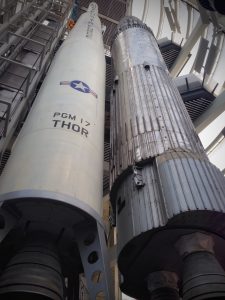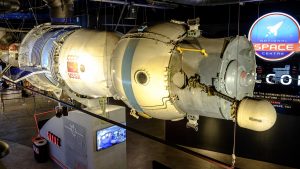June 17, 2017
Visit to the National Space Centre in Leicester – 17th June 2017
Report by Christina Chester
Everything about the National Space Centre in Leicester is suggestive of the grandeur and excitement of space travel. A visit, arranged for Saturday 17th June by Mike Meynell, gave Flamsteed members the opportunity to see this attraction that’s dedicated to space exploration and space science.
Upon entering the National Space Centre’s space-themed sliding doors, we were immediately greeted with Soyuz, known officially as a ‘Soyuz 7K-OK’, which is mounted from the ceiling. This Soviet-era spacecraft is an impressive sight! What is most striking about it is that it’s displayed with all three parts connected: the descent module, the orbital module that allows crew a bit more room during orbit, and the service module that contains the electronics and the fuel tanks. This is a rare display as the descent module is the only part of the spacecraft that returns to Earth as the other two modules are discarded and left to burn up in the Earth’s atmosphere. It was also interesting to see how little has changed in the appearance between this first generation spacecraft that was used in the Salyut space station programme and the Soyuz spacecrafts used to ferry humans into space today. As the saying goes, if it ain’t broke, don’t fix it!
Past Soyuz and through the ticket hall, we had some time to wander around a few of the interactive galleries before our pre-booked 11.10am ‘We are Stars’ show in the Sir Patrick Moore Planetarium. Many of us in the group had missed seeing this show when it was screened in the Peter Harrison Planetarium at the Royal Observatory Greenwich so it was good to finally get to explore the secrets of our cosmic chemistry and origins.
Our tickets also included a journey to Jupiter’s moon, Europa. Well, not quite! We jumped aboard the 3D Simulator Experience and were whisked away to the icy moon at breakneck speed, diving through the ridges that are etched across the moon’s surface. Our journey came to a bit of a bumpy end but we all lived to tell the tale!
The afternoon allowed us to explore the galleries some more, with time to discover the wonders of the Solar System and beyond. We took a stroll through a mock-up of the Columbus Module from the International Space Station and investigated the effects of gravity on different planets with the Baked Bean Challenge. There are lots of interactive exhibits and things to keep both the young and us grown-up kids amused.
A visit to the National Space Centre would not be complete without seeing the 42m high Rocket Tower which is home to the British designed Blue Streak (F16) rocket and the Thor-Able rocket. Displayed standing vertically, it’s easy to imagine these rockets on a launch pad about to take off… they are enormously tall too! Though associated with a harrowing past, in that the initial driving force for the development of this technology was a weapons race for intercontinental ballistic missiles, it was interesting to read about how the technologies advanced over a short period of time in the fiercely competitive, cut-throat Soviet-American relations of the 1960s.
The Space Race really comes alive here as the exhibition is complete with a living room scene, set in the 1960s with genuine vintage furniture and a TV set playing the grainy, flickering footage from the first Moon landing. It really took you there and it was easy to imagine what it must have felt like to experience watching Neil Armstrong step off the Eagle lunar lander and proclaim “That’s one small step for a man, one giant leap for mankind”, an immortalised quote. When you look up at the Moon you think about that footage, no matter how old or young you are. What a brilliant way to help those without their own memories of the Apollo programme capture some of that excitement and wonder.
Pictures from the Trip (by Christina Chester and Mike Meynell):
Posted under: Flamsteed, Society Trip









You must be logged in to post a comment.